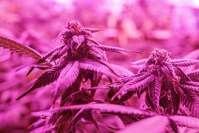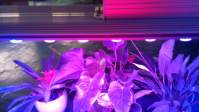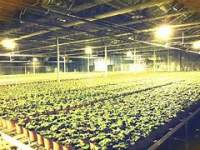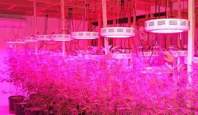Yaorong manufacturer tells you the tips for choosing 720w led plant light to fill light!
With the continuous development of technology, people have developed lamps that can replace sunlight to fill plants with light-led plant supplement light. LED plant supplement light has the characteristics of environmental protection, energy saving and green development, and can be used in any place. Time can add light to plants.
The sensitivity of plants to the spectrum is different from that of the human eye. The most sensitive spectrum of the human eye is at 555nm, which is between yellow and green light. The sensitivity to the blue light zone and the red light zone is relatively poor. This is not the case with plants. They are most sensitive to the red light spectrum and less sensitive to green light, but the difference in sensitivity is not as wide as the human eye. The most sensitive area of plants to the spectrum is 400-700nm. This section of the spectrum is called the effective energy region of photosynthesis. Approximately 45% of the energy of sunlight lies in this section of the spectrum. If an artificial light source is used to supplement the amount of light, the spectral distribution of the light source should also be close to this range.
The energy of the photons emitted by the light source varies depending on the wavelength. For example, the wavelength of 400nm (blue light) is 1.75 times the energy of 700nm (red light). But for photosynthesis, the effect of the two wavelengths is the same. The excess energy in the blue spectrum that cannot be used for photosynthesis is converted into heat. In other words, the photosynthesis rate of a plant is determined by the number of photons that the plant can absorb in the 400-700nm range, and is not related to the number of photons sent by each spectrum. However, the general knowledge of most people is that the color of light affects the rate of photosynthesis. Plants have different sensitivity to all spectra. The reason for this is the special absorption of pigments in the leaves. Among them, chlorophyll is the most known. But chlorophyll is not the only pigment useful for photosynthesis. Other pigments are also involved in photosynthesis, and the efficiency of photosynthesis cannot only consider the absorption spectrum of chlorophyll.
The difference in photosynthesis path is also not related to color. Light energy is absorbed by the chlorophyll and carotene in the leaves. Energy is converted into glucose and oxygen by two photosynthetic systems to fix water and carbon dioxide. This process uses the spectrum of all visible light, so the effects of light sources of various colors on photosynthesis are almost the same.
The researchers of Yaorong Technology believe that there is the greatest photosynthesis ability in the orange-red light part. But this does not mean that plants should be cultivated in such a monochromatic light source. In terms of the morphological development and leaf color of plants, plants should be light sources that receive various balances.
The blue light source (400-500nm) is very important for plant differentiation and stoma regulation. If the blue light is insufficient, the ratio of far red light is a little too much, and the stems will grow excessively, which will easily cause yellowing of the leaves. The ratio of the energy of the red light spectrum (655~665nm) to the energy of the far-red light spectrum (725~735nm) is between 1.0 and 1.2, and the development of plants will be positive growth. However, the sensitivity of each plant to these spectral ratios is also different.

In the greenhouse, 720w led plant lights are often used as artificial light sources. It has the highest energy in the orange-red spectral region. However, the energy of far-infrared light is not very high, so the ratio of red light/far-red light energy is greater than 2.0. However, since the greenhouse still has natural sunlight, it did not cause the plants to become shorter. (If this light source is used in the growth box, it may have an impact.)
Under natural sunlight, blue light energy occupies 20%. For artificial light sources, such a high ratio is not necessary. For normal plants, most plants only need 6% blue light energy in the 400-700nm range. Under natural sunlight, there is enough blue light energy. Therefore, the artificial light source does not need to add more blue light spectrum. However, when the natural light source is insufficient, the artificial light source needs to increase the blue light energy, otherwise the blue light source will become a factor that restricts the growth of plants. However, if the method of improving the light source is not used, there are still other methods to remedy the problem of insufficient light source. For example, temperature adjustment or the application of growth hormones.
Shenzhen Yaorong Technology Co., Ltd. is a company specializing in the research and development and production of LED plant lights in my country. It has been engaged in the development, production and sales of LED plant growth lights for more than ten years. The products have nearly 10 years of overseas export experience and qualifications. As an important domestic supplier of led plant lights, the products are also supplied to Europe and the United States for a long time. Tissue culture plant lights and industrial hemp plant lights and modern three-dimensional farm plant supplement light lamps and system applications have a complete and mature plant spectrum technology and plants. The application scheme of fill light.
Led plant supplement light can provide sufficient light for plants to grow healthily, and can even increase crop yield and advance the market and enhance the quality. However, all prerequisites are to choose the correct led plant supplement light.
So how to correctly choose and use led plant light to supplement light for plants? The following are some tips about 720w led plant lights that the technicians of Yaorong Technology led plant supplement light manufacturers have learned about.
1. Many people will choose red and blue lights to supplement light for plants, but different plants have different requirements for the ratio of red and blue, so when choosing, choose the correct ratio according to the type of plant Red and blue fill light.
2. The power of led plant supplement light affects the light intensity, and the light intensity has a great influence on plant growth. The light intensity of the led plant supplement light will have an effect on plant growth only when it reaches the light compensation point of the plant, so pay attention to the power of the led plant supplement light.
3. When choosing the power of the supplement light, pay attention to whether the LED plant supplement light has enough watts. Many manufacturers' LED plant supplement light has insufficient power, so the effect will be very weak.
4. When using the fill light, pay attention to the distance between the light and the plants. Plant supplement light will heat up. If it is too close, it will burn the plant. If it is too far away, it will weaken the effect of supplementing light on the plant. The distance between the lamp and the plant should be considered according to the power of the LED plant supplement light lamp, too far will affect the light intensity.
What should we consider when buying led grow lights?
Shenzhen LED plant growth lamp Yaorong Technology manufacturer, to explore the production line of Yaorong Technology LED full-spectrum plant supplement light
When understanding the different led plant growth lights, you must know why consideration will help planting. There are several key points when making purchase recommendations. If you want to find the best 720wled plant light for your crop, please carefully consider the following precautions.
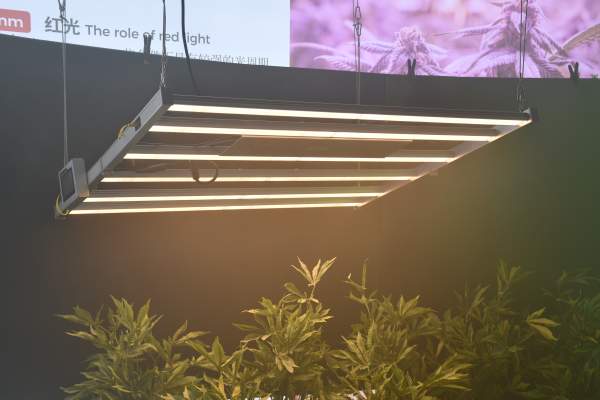
Price and long-term cost
We can’t imagine a product we need and say that it is it. Everyone wants to spend the least money to buy the most effective led plant light. Although the price is very important, it is largely determined by each user. Situation and long-term goals. We see LED, HID and CFL lights on the market, and the price will vary according to the type. Don’t forget that lighting lights are also accompanied by corresponding operating costs!
Need to consider how much energy each type of led plant light consumes during operation
Some lamps are much cooler (cold light source + excellent heat dissipation), while others have to dissipate a lot of heat. If you choose this type of lamp, it may require cooling equipment.
Wattage-can be simply understood as how much light does the plant actually get?
It must be considered to obtain the optimal amount of light for the growth room. Too much light is not good, and too little light is not conducive to plant growth.
What is the perfect amount of light used up? How much light is suitable for growing crops?
1. The length of the growth room x width = total growth surface,
2. The content of PPFD required for the total growth surface x,
3. Divide the result of the previous equation by the PPFD per watt,
4. This can provide you with the exact amount of power required by your room area.
What is the PPFD per watt? When buying 720wled plant lights, we can consult the supplier for these data, and then take these two values and perform some simple mathematical operations to get the ratio of PPFD per watt.
Temperature and cooling system
Certain types of led plant lights will produce a lot of heat, too much heat is bad for plants, because heat will damage the growth of plants and burn them.
The best led grow lights should be good at managing heat output. Generally speaking, LED plant grow lights are the best choice. Compared with HID, their heat emission is reduced to about 50%. Most of this heat comes from the circuit board (heat effect of current).
In contrast, HID lamps generate a lot of heat energy. What's worse is that this energy is released into the air in the form of infrared radiation, and then directly enters the plants.
Therefore, please note that HID lamps will generate more heat (useless work, waste of electrical energy) than LED plant lamps, and require better heat dissipation. The user needs to install a comprehensive airflow cooling system next to it. If the weather in the city is hotter, it is also necessary to install an air conditioner. -These are to be included in the total cost.
Octopus planting light led plant growth light cross-border greenhouse indoor plant fill light
Easy to use and install
The user may not be familiar with the method of growing marijuana at home, perhaps the user has never even installed a light before. Therefore, the best thing is that users need led plant lights that are easy to use and install as simple as possible.
LED plant lights are very advantageous in this field, and they don’t need to be replaced frequently. Compared with the non-ventilated HID system, the cooling demand is reduced by 40-50%. When the LED plant growth light is used in the tent, there will be a lower risk of fire hazard.
Fluorescent lights work the same way as ordinary lighting in our homes, and they are also easy to install.
Using the HID system, users will need about 50% more heat dissipation requirements, and may need to replace a single lamp from time to time. But most importantly, if they are not installed and maintained, they can cause a fire in the tent.
If the user is accustomed to setting up "things with cables and wires", then they may find it easy to install them. If we are not cold to these, then plug-and-play LED plant growth lights are more suitable.
Yaorong Technology 720W foldable dimmable led plant growth light full spectrum plant fill light imitating sunlight
In the past few years, the continuous development of technology has made LED grow lights the best choice for keen cannabis growers.
The LED planting light is in the form of a panel, which is very helpful when a larger coverage area is needed. As mentioned earlier, they are very effective, especially when we compare LED grow lights with other light sources. This means that if users choose LED solid-state cold light source plant lights, it can effectively reduce operating costs.
Another key feature of the LED lamp is that it retains a considerable amount of brightness. Usually, the lamp will attenuate as we use it until we need to replace it. This problem does not exist with LED planting lights, and users do not have to worry at all for at least 2-3 years.
LED grow lights will still provide more power than many other products. Although this can be seen as an advantage, the distance between it and the plants should be controlled well.
The packaging design and radiator design of LED grow lights are equipped with passive cooling systems that can prevent the lights from overheating and increase the temperature of the lights. This is why the best growth cabinets are usually equipped with LED lights.
For other lights, the user may need to purchase additional items to connect the lights. This problem does not exist with LED plant lights, because users only need to plug them in and hang them. This is all the user has to do, so this is a good choice for growers.
One of the outstanding features of LED plant lights is that they surround the spectrum. LED plant lightcan easily configure the wavelength of a specific spectrum, and there are some plant light products that allow us to switch or adjust the color spectrum by ourselves. This means that we can set more blue light in the growth stage of the plant, and then gradually increase the red light to enter the flowering state. Therefore, by using LED plant lights, it is possible to obtain more effective growth and obtain greater benefits from cannabis.


